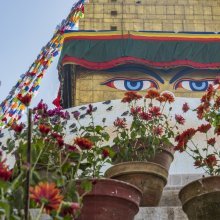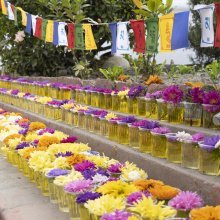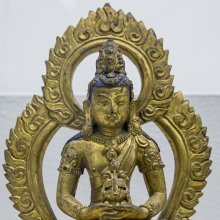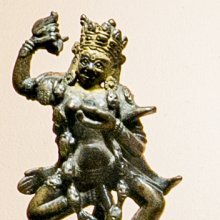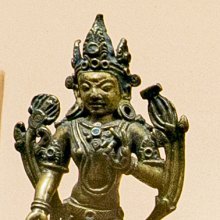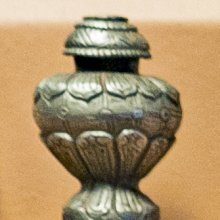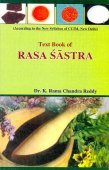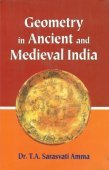Filling, Filled: 2 definitions
Introduction:
Filling means something in Hinduism, Sanskrit, the history of ancient India. If you want to know the exact meaning, history, etymology or English translation of this term then check out the descriptions on this page. Add your comment or reference to a book if you want to contribute to this summary article.
Images (photo gallery)
(+18 more images available)
In Hinduism
Yoga (school of philosophy)
Source: ORA: Amanaska (king of all yogas): A Critical Edition and Annotated Translation by Jason BirchFilling (one’s stomach) is denoted by the Sanskrit term Pūraṇa, according to the Amanaska Yoga treatise dealing with meditation, absorption, yogic powers and liberation.—Accordingly, as Īśvara says to Vāmadeva: “[...] Putting on ochre garments, carrying a skull, plucking out clumps of hair, maintaining non-vedic religious observances, ashes, ascetic clothing and matted locks, behaving as if mad, [the ascetic practice of] nakedness, [studying] the Vedas, Tantras and so on and the meeting [of learned people] for [reciting] poetry in the assembly: All [this] is exertion for the sake of filling (pūraṇa) one's stomach and is not the cause of the highest good. [...]”.

Yoga is originally considered a branch of Hindu philosophy (astika), but both ancient and modern Yoga combine the physical, mental and spiritual. Yoga teaches various physical techniques also known as āsanas (postures), used for various purposes (eg., meditation, contemplation, relaxation).
India history and geography
Source: Singhi Jain Series: Ratnaprabha-suri’s Kuvalayamala-katha (history)1) Filling (sheets of gold) was a process used by the Goldsmith in ancient India, according to “A Cultural note on the Kuvalayamala of Uddyotanasuri” by the late Dr. V. s. Agrawala.—There is a reference to gold of highest purity. Whatever impurity or dross was contained in the gold brought to the goldsmith was removed by the latter by subjecting it to different processes of testing it on the touch-stone, cutting, heating under regulated fire, beating out into flat sheets, filing the sheets and the same process of beating it into a different shape, giving it a shape of round bar and dividing into several parts for final testing.
2) Filling (the containers with fresh sweet water) refers to certain preparatory rituals performed before Sea-voyages in ancient India (known in Prakrit as: jattā, or Sanskrit: yātrā), and was vividly depicted in the Kathās (narrative poems) such as Uddyotanasūri in his 8th-century Kuvalayamālā (a Prakrit Campū, similar to Kāvya poetry).—Details of preparation for sea-voyage are given which include the following items relating to preparatory ritual and the equipment of the ship: [e.g., filling the containers with fresh sweet water;] [...]. When the ship was to take off auspicious musical instruments were sounded, conch-shells were blown, auspicious songs were sung, [...].

The history of India traces the identification of countries, villages, towns and other regions of India, as well as mythology, zoology, royal dynasties, rulers, tribes, local festivities and traditions and regional languages. Ancient India enjoyed religious freedom and encourages the path of Dharma, a concept common to Buddhism, Hinduism, and Jainism.
See also (Relevant definitions)
Full-text (+3129): Purana, Purita, Pratipurana, Bharita, Padapurana, Apurana, Akirna, Puraka, Purayitri, Apurna, Bhrita, Bharati, Purna, Samprina, Vyapin, Purnakumbha, Prapurita, Nirbhara, Paripuraka, Abhipurana.
Relevant text
Search found 393 books and stories containing Filling, Filled; (plurals include: Fillings, Filleds). You can also click to the full overview containing English textual excerpts. Below are direct links for the most relevant articles:
Satapatha-brahmana (by Julius Eggeling)
Kāṇḍa X, adhyāya 5, brāhmaṇa 4 < [Tenth Kāṇḍa]
Kāṇḍa VIII, adhyāya 7, brāhmaṇa 4 < [Eight Kāṇḍa]
Kāṇḍa VIII, adhyāya 1, brāhmaṇa 4 < [Eight Kāṇḍa]
The Shiva Purana (by J. L. Shastri)
Chapter 10 - The mode of sufferings in the Hell < [Section 5 - Umā-Saṃhitā]
Chapter 17 - The fight between Viṣṇu and Jalandhara < [Section 2.5 - Rudra-saṃhitā (5): Yuddha-khaṇḍa]
Chapter 18 - The procedure of initiating a disciple < [Section 6 - Kailāsa-saṃhitā]
Dhammapada (Illustrated) (by Ven. Weagoda Sarada Maha Thero)
Verse 122 - The Story of Bilālapādaka < [Chapter 9 - Pāpa Vagga (Evil)]
Verse 58-59 - The Story of Garahadinna < [Chapter 4 - Puppha Vagga (Flowers)]
Verse 123 - The Story of Mahādhana < [Chapter 9 - Pāpa Vagga (Evil)]
Bharadvaja-srauta-sutra (by C. G. Kashikar)
Jnaneshwari (Bhavartha Dipika) (by Ramchandra Keshav Bhagwat)
Verse 11.20 < [Chapter 11 - Vishvarupa-darshana-yoga]
Verse 11.45 < [Chapter 11 - Vishvarupa-darshana-yoga]
Verse 11.24 < [Chapter 11 - Vishvarupa-darshana-yoga]
The Skanda Purana (by G. V. Tagare)
Chapter 9 - Filling up the Nāgabila < [Section 1 - Tīrtha-māhātmya]
Chapter 1 - A Hollow Near the Hermitage of Vasiṣṭha < [Section 3 - Arbuda-khaṇḍa]
Chapter 214 - The Greatness of Śrī Kapāla Tīrtha < [Section 3 - Revā-khaṇḍa]
Related products
(+4 more products available)
